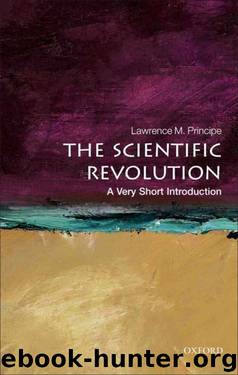The Scientific Revolution: A Very Short Introduction (Very Short Introductions) by Principe Lawrence M

Author:Principe, Lawrence M. [Principe, Lawrence M.]
Language: eng
Format: epub
Publisher: Oxford University Press
Published: 2011-04-27T16:00:00+00:00
Motion on Earth
While the magnetic philosophy tried to explain why bodies fall, Galileo endeavoured to describe mathematically how they fall. He built inclined planes, pendula, and other devices to study terrestrial motion. His Two New Sciences (1638), written while under house arrest, was the culmination of a study of motion he began in the 1590s. He discovered, contrary to Aristotle’s claim, that all bodies fall at the same rate regardless of weight. With elegant logic he argued that if a ball rolled down an inclined plane speeds up and one rolled up an inclined plane slows down, then one rolled on a level surface – neither up nor down – would maintain a constant speed. Since on Earth that ‘level’ surface would actually be the curved surface of the globe, a ball rolled on its perfectly polished surface would circle it for ever. Using this ‘thought experiment’, Galileo both enunciated a principle of inertia (that moving bodies keep moving unless acted upon by an external agent), and brought the eternal circular motion of the heavens down to Earth – further eroding the distinction between sublunar and superlunar realms.
Methodologically, what Galileo ignored is as important as what he paid attention to. In describing motion, he never concerned himself with what is moving – a ball, an anvil, or a cow. In short, he ignored the qualities of bodies that Aristotelian physics emphasized. Galileo favoured instead their quantities, their mathematically abstractable properties. By stripping away an object’s characteristics of shape, colour, and composition, Galileo gave idealized mathematical descriptions of its behaviour. A cold brown ball of oak doesn’t fall any differently than a hot white cube of tin; Galileo reduces both objects to abstract, decontextualized entities able to be treated mathematically. A group known as the Oxford Calculators had begun applying mathematics to motion in the 1300s; in fact, Galileo begins his exposition of kinematics in the Two New Sciences with a theorem they enunciated. But Galileo went much further by linking mathematical abstraction tightly with experimental observation. As he conducted innumerable experiments, he sifted out air resistance and friction as ‘imperfections’ from the ideal mathematical behaviour that can be experienced only in thought. Plato, with his idea of a world that only imperfectly follows the eternal mathematical patterns according to which it was fashioned, might have found something to agree with in Galileo’s perspective (even if Aristotle would have objected). Evoking the Christian image of the ‘Book of Nature’, Galileo wrote famously that ‘this grand book, I mean the universe … is written in the language of mathematics, and its characters are triangles, circles, and other geometrical figures, without which it is humanly impossible to understand a single word of it’. The technique of reducing the physical world into mathematical abstractions, and eventually into formulas and algorithms, championed by Galileo, played a key role in producing a new physics, and stands as a distinctive feature of the Scientific Revolution.
Significantly, Galileo is content to describe motion mathematically without worrying about its cause.
Download
This site does not store any files on its server. We only index and link to content provided by other sites. Please contact the content providers to delete copyright contents if any and email us, we'll remove relevant links or contents immediately.
Periodization Training for Sports by Tudor Bompa(8170)
The Body: A Guide for Occupants by Bill Bryson(4974)
The MacArthur Bible Commentary by John MacArthur(4749)
The Sports Rules Book by Human Kinetics(4291)
What It Really Takes to Get Into Ivy League and Other Highly Selective Colleges by Hughes Chuck(3696)
Marijuana Grower's Handbook by Ed Rosenthal(3620)
The Sprouting Book by Ann Wigmore(3543)
The Martian by Andy Weir(3306)
Salt, Fat, Acid, Heat: Mastering the Elements of Good Cooking by Nosrat Samin(3107)
The Bread Bible by Rose Levy Beranbaum(3004)
Harry Potter 4 - Harry Potter and The Goblet of Fire by J.K.Rowling(2990)
Sapiens and Homo Deus by Yuval Noah Harari(2987)
The Marketing Plan Handbook: Develop Big-Picture Marketing Plans for Pennies on the Dollar by Robert W. Bly(2975)
Classic by Mary Berry(2941)
Martha Stewart's Baking Handbook by Martha Stewart(2796)
Screenplay: The Foundations of Screenwriting by Syd Field(2574)
The Plant Paradox by Dr. Steven R. Gundry M.D(2547)
50 Economics Classics by Tom Butler-Bowdon(2523)
The Cambridge Grammar Of The English Language by Rodney Huddleston Geoffrey K. Pullum(2382)
